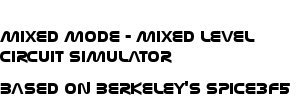Ngspice Frequently Asked Questions
- Document Revsion: 1.7
- Document Maintainer: Holger Vogt
- Last Update: 17-03-2018
F.A.Q. Table of Contents
- 1. INTRODUCTION AND GENERAL INFORMATION
- 1.1 What is ngspice?
- 1.2 Why resurrecting Berkeley's Spice?
- 1.3 What is the project's goal?
- 1.4 What you are going to do?
- 1.5 Legal issues
- 1.6 What mailing lists exist for ngspice?
- 1.7 Are the mailing lists archived anywhere?
- 1.8 What newsgroups exist for ngspice?
- 1.9 Where can I get a copy of ngspice?
- 1.10 Where should I look on the World Wide Web for ngspice stuff?
- 1.11 Where should I look on the World Wide Web for Spice documentation?
- 2. DEVELOPMENT
- 2.1 What is the current version?
- 2.2 What are the latest features in the current release?
- 2.3 What does it look like?
- 2.4 Who are the authors of ngspice?
- 2.5 How can I report a bug/request for a feature?
- 2.6 How can I join the development?
- 3. SOLUTIONS TO COMMON MISCELLANEOUS PROBLEMS
- 3.1 What systems are supported?
- 3.2 I get errors when I try to compile the source code, why?
- 3.3 This document didn't answer my question. Where else can I look for an answer?
- 4. ADMINISTRATIVE INFORMATION AND ACKNOWLEDGEMENTS
- 4.1 Feedback
- 4.2 Formats in which this FAQ is available
- 4.3 Authorship and acknowledgements
- 4.4 Disclaimer and Copyright
- Spice3 is the most famous and used circuit simulator. It was developed University of California at Berkeley (UCB), by "a cast of thousand" (as they say).
- Cider is a mixed-level simulator that already includes Spice3f5 and adds a device simulator to it: DSIM. Cider couples the circuit level simulator to the device simulator to provide greater simulation accuracy (at the expense of greater simulation time). Critical devices can be described with technology parameters (numerical models) and non critical ones with the original spice's compact models.
- Xspice is an extension to Spice3 that provides code modeling support and simulation of digital components through an embedded event driven algorithm.
- The NG prefix has lot of meanings: Next Generation, New Good, etc. Choose or invent the one you prefer. The heart of the project is the ngspice program.
Xspice is a mixed-signal circuit simulator developed by GTRI (Georgia Tech Research Institute) at Georgia Institute of Technology. Xspice was originally developed as an extension over Spice3c1. Xspice introduces code modeling and a digital simulator into ngspice. The "home site" of Xspice at GTRI is no longer available.
Cider is a mixed-level circuit and device simulator based on Spice3f5 that couples a device simulator (DSIM) to Spice.
The merging process has been done some 10 years ago, accompanied with bug fixing and improvement of the three simulators. The improvements are concentrated into 7 directions:
-
Compact models: the improvements in compact models will address mainly the implementation of additional effects not available in the original code. Device specific improvements are documented on ngspice's documentation and in the DEVICE file in project's tarball.
Improvements that affects all devices already implemented are: "dtemp" option to set instance's temperature relative to the circuit one and "m" parallel multiplier to simulate an arbitrary number of instances of the same kind connected in parallel.
-
Simulator's analyses: this is a low priority area. Planned improvements include the implementation of parametric analyses, to analyse the behaviour of the circuit as a parameter changes. Parameter sweep, Monte Carlo and Worst Case fall in this category.
-
Numerical analysis code: the improvements within the numerical code must be done with extreme care. Planned improvements are the use of a KLU library as possible Sparse library replacement and the upload of matrix solver and device evaluation to the GPU.
-
Spice language: The language used to input the circuit to the simulator has been extended and now allows the user to input parametric values for components (the numparam library). Planned improvements includes a better support for circuit hierarchy, and netlist manipulation via command line (adding and removing instances).
-
Frontend: The design of a new spice frontend is not of interest because free and commercial frontends are available.
-
ngspice as shared library: ngspice may be compiled as a shared library with a C interface offering access to all simulation data and allowing full control of the simulator from a calling program. By integrating tclspice, ngspice may also be compiled as a TCL/TK library.
-
Documentation: Commercial simulators come with very good manuals containing tutorials, description of models equations, example of use, suggestions, etc. Spice came with little documentation. The Spice3f manual, available on the Internet has been used as the basis for the new manual. It will be constantly improved during ngspice development and will be timely available with each new release.
Users mailing list: <ngspice-users@lists.sourceforge.net> This list is for ngspice users, examples, problems, bug reports and general discussion on ngspice can be sent here.
Developers mailing list: <ngspice-devel@lists.sourceforge.net> The list dedicated to ngspice development. Developers shold subscribe here, to follow the program development. May be used to send patches, and technical discussion on ngspice.
Send an empty message with Subject "help" to the following addresses to get instructions.
ngspice-users-request@lists.sourceforge.net
ngspice-devel-request@lists.sourceforge.net
Send an empty message to the following address to Subscribe.
ngspice-users-join@lists.sourceforge.net
ngspice-devel-join@lists.sourceforge.net
Documentation about the user interface of these mailing lists can be found at:
- sci.electronics.cad
- comp.lsi.cad
The Spice Home Page:
http://bwrc.eecs.berkeley.edu/Classes/IcBook/SPICE/
The Spice Download Page:
http://embedded.eecs.berkeley.edu/pubs/downloads/spice/index.htm
Cider Page:
https://ptolemy.berkeley.edu/projects/embedded/pubs/downloads/cider/
Spice benchmarks:
https://web.archive.org/web/20040607135318/http://www.cbl.ncsu.edu/CBL_Docs/csim90.html
- ngspice-36 (released on 01/01/2022)
There is no bureaucracy here.
Write a mail to the user's list describing the problem and providing information on the type of hardware, the flavour of operating system.
ngspice-users@lists.sourceforge.net.



